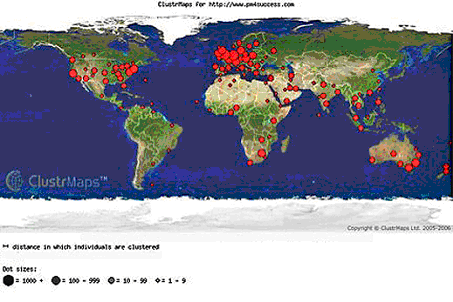|
In this Part 1 of our two-part paper we will introduce
the PRINCE2 project management methodology, the book's structure and what we liked.
In Part 2 we'll cover some special concepts specific to PRINCE2,
some of the downsides we see from our perspective, and we'll finish with our summary
conclusions.
Introduction
For those not familiar with this book, the Office of Government Commerce (OGC,
UK) publishes Managing Successful Projects with PRINCE2. It is a prescriptive
manual describing in detail a structured method for the effective management of a
project. The latest version contains 456 pages, a 12% increase over its 2002 predecessor.
PRINCE2 is a widely recognized de facto standard used extensively by governments and
the private sector in the UK and around the world, see Figure 1.

Figure 1
The widespread use of PRINCE2 owes much to the fact that it can be tailored and
scaled to all manner of projects and situations. According to the APM Group:[1]
It has become an international standard, with organizations around the world using
it as their preferred approach to managing projects. This is reflected in the fact
that:
- The PRINCE2 Manual is currently available in English, Danish and Mandarin Chinese,
and is being translated into Dutch, French, German, Polish and Spanish
- The PRINCE2 Pocketbook has been translated into Italian and is currently being
translated into French and German
- The PRINCE2 Glossary of Terms is available in English, Arabic, Bulgarian, Danish,
Dutch, French, German, Greek, Italian, Japanese, Mandarin Chinese, Russian, Polish,
Spanish and Vietnamese.
The method was first promulgated around 1989 and has since gone through a number
of incarnations. We last reviewed PRINCE2 in some detail in its 2002 Edition back
in November 2002 - see http://www.maxwideman.com/papers/comparing/intro.htm.
However, we did so to draw a comparison with the Project Management Institute's Guide
to the Project Management Body of Knowledge.
Since then, the Guide has been updated to its third revision (2004) and PRINCE2
was updated to its latest revision last year. We reviewed the 2004 version of the
Guide in considerable depth in papers from March to May 2005 - see http://www.maxwideman.com/papers/pmbok3/intro.htm.
Moreover, the team leader of the latest PRINCE2 update, Colin Bentley, has written
his own comparison between the latest versions of the two documents - see http://www.maxwideman.com/guests/prince-pmbok/note.htm.
So now we feel it is appropriate to examine the latest version of PRINCE2, in its
own right.
"PRINCE" stands for PRojects IN Controlled Environments
and is described as a structured method for effective project management. It is based
on the experiences of scores of projects, project managers and project team who have
contributed, some from their mistakes or omissions, others from their successes.[2]
According to the Foreword, it is recognized as a world-class international product
and is the standard method for project management, not least because it embodies many
years of good practice in project management and provides a flexible and adaptable
approach to suit all projects.[3]
The manual itself is limited in its scope first because it draws a distinction
between "product life span" and "project life cycle" as shown in Figure
2. From the manual's perspective, the latter is only a small part of the former
and consequently only covers the execution period of the project. This is so even
though the "Business Case drives all the project management processes, from initial
project set-up through to successful finish",[4]
it, together with the development of the solution to the need and intermediate-level
planning, are not included under the terms of the manual. It may be concluded that,
in PRINCE2's view, the project does not start until the earlier work, including any
feasibility studies, and so on, actually move into formal and physical execution.
Figure 2: The product life span and project life cycle ranges in PRINCE2[5]
For direction on managing the earlier parts of a project, or "pre-project" in PRINCE2
terms, you must refer to a companion document, Managing Successful Programmes
(MSP), also published by OGC. We reviewed this document in March 2006 - see http://www.maxwideman.com/papers/successful/intro.htm.
As the MSP name implies, this volume is focused on managing collections of projects
such as "Making and delivering"; "Organizational Change"; and "External societal change"
projects. That means that the "front end" of these projects do not receive dedicated
attention as they tend to do in North America, but rather as a part of, and in competition
with, any and all other projects that are being contemplated.
Second, as it says in the text, "PRINCE2 assumes that the project is run within
the context of a contract".[6] This statement
is made in the discussion of purchasing so it obviously contemplates a legal contract.
However, elsewhere there seems to be some ambivalence over this, where the context
suggests the possibility of an "internal" commitment between divisions of a large
organization. In short, the methodology does not appear to be suited to the large
number of relatively modest in-house IS/IT projects in corporate IT departments.
Third, the general tone of the content suggests application to projects of significant
value or complexity conducted under rigorous conditions of "high ceremony". These
are projects such as you may find in governments at all levels, the process industries,
engineering and construction companies, and the like. Indeed, PRINCE2 observes that:
"Without a project management method, projects are rarely completed on time and within
acceptable cost - and this is especially true of large projects.[7]
However, PRINCE2 does say: "tailoring the method to suit the circumstances of a particular
project is critical to its successful use."[8]
In fact, where applicable, the standard format of the process descriptions includes
a comment on "scalability".
1. Embedding Best Practice, The APM Group Ltd, UK, June 2006
2. PRINCE2, 2005 Edition, Office of government Commerce, UK, 2005, p1
3. Ibid, p v
4. Ibid
5. Ibid, Figure 2.1, p8
6. Ibid, p8
7. Ibid, p2
8. Ibid, p9
|



